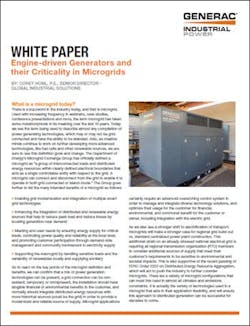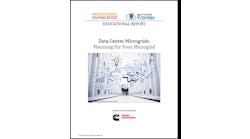Engine-Driven Generators Continue to Enable Application Flexibility for Microgrid Operations
Microgrids are designed to increase energy resiliency and reliability, both of which are becoming increasingly important in an era wracked by climate change and a global pandemic. A new report from Generac contends that engine-driven generators burning a variety of fossil fuels can provide last-step resiliency for the microgrid that “cannot be offered by wind, solar, battery storage or any other renewable source of power.”
Get the full report.
Generac points out that engine-driven generators are a proven approach, and the technology can help ensure complete resiliency for today’s microgrid, which is growing more and more dependent on renewable energy.
According to the report, if the microgrid project developer decides to include an engine-driven generator in their microgrid project, the next decision they have to make is around potential fuel supply options.
For most applications, the report says, there would be three main fueling options typically considered in a stationary industrial generator: diesel, natural gas and propane.
“Other fuel choices like biogas, renewable natural gas bifuel, heavy fuel oil and hydrogen are or will continue to be niche offerings for the foreseeable future,” Generac adds.
The right choice will vary by project, depending on factors such as capital expenditure, fuel tank rental, fuel maintenance requirements, availability of natural gas pipeline, resiliency or total runtime required, site storage options, equipment maintenance and more.
“With the overall aging of the grid and increasing dependence on intermittent renewables, the grid today is facing great challenges to reliability and resiliency.” — Generac
The report also explores alternative uses and return on investment through economic dispatch, which Generac asserts are often overlooked in the study of microgrids.
For example, in the past, generators have often been assumed to be used only in the case of emergency, such as failure of solar, wind or other technologies and energy sources.
That said, the report states, “It is becoming increasingly popular to enroll these normally dormant standby assets in such highly profitable utility support programs that go by names such as multiple peak reduction, global adjustment, demand response, daily dispatch and others.”
Further, the report highlights another trend in the distributed generation space in which engine-driven generators can be cost-effective aids to the local grid — the utility scale microgrid.
There is a growing opportunity to address grid resiliency and reliability issues with purpose-built utility scale power plants.
“These plants can be configured with natural gas generators and offer a cost-effective means of addressing the market power gap without concerns for fuel supply limitations,” the report says.
Download the full report, “Engine-driven Generators and their Criticality in Microgrids,” courtesy of Generac, to further explore the role engine-driven generators can play in microgrid operation today.







